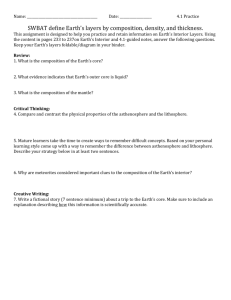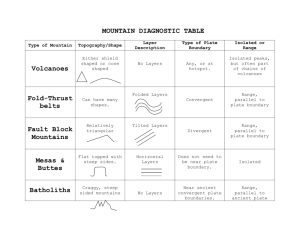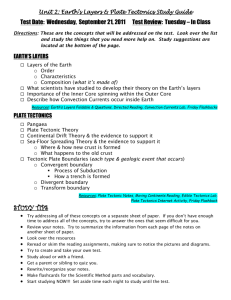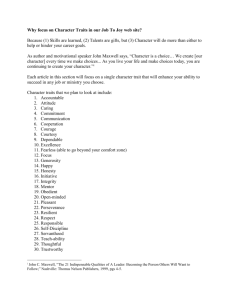MULTILAYERED VISCOELASTIC OF MAXWELL SOLIDS ORTHOTROPIC
advertisement
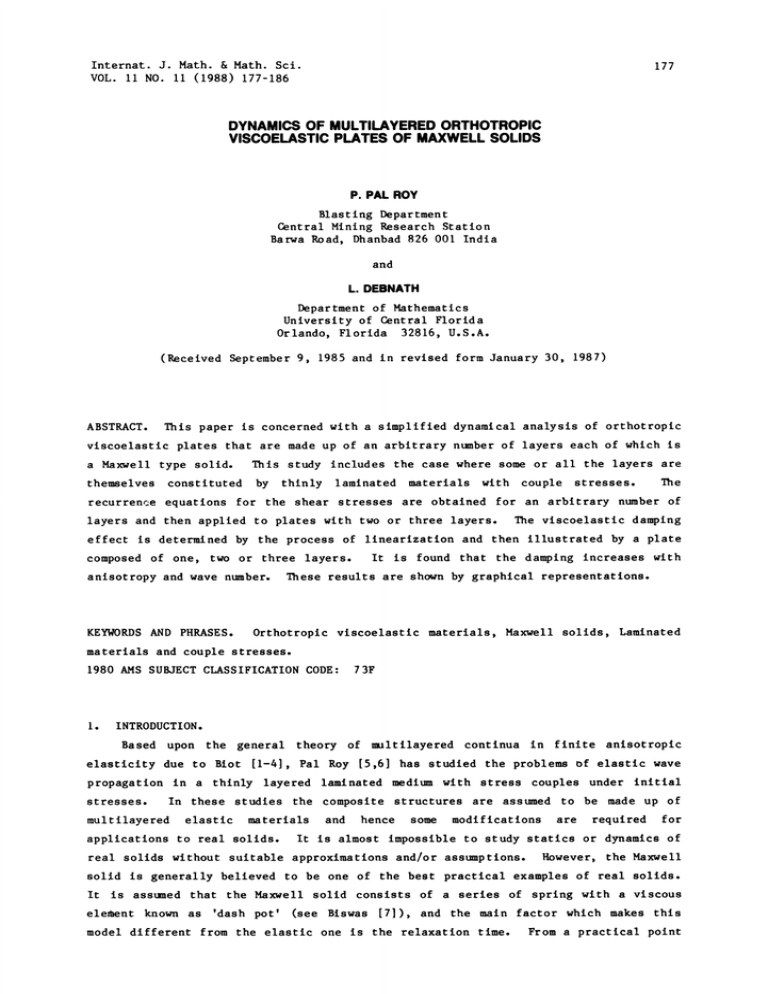
Internat. J. Math. & Math. Sci. VOL. ii NO. ii (1988) 177-186 177 DYNAMICS OF MULTILAYERED ORTHOTROPIC VISCOELASTIC PLATES OF MAXWELL SOLIDS P. PAL ROY Blasting Department Central Mining Research Station Barwa Road, Dhanbad 826 001 India and L. DEBNATH Department of Mathematics University of Central Florida Orlando, Florida 32816, U.S.A. (Received September 9, 1985 and in revised form January 30, 1987) ABSTRACT. This paper is concerned with a simplified dynamical analysis of orthotroplc viscoelastic plates that are made up of an arbitrary number of layers each of which is a Maxwell type solid. themselves constituted This study includes the case where some or all the layers are by thinly laminated materials with couple stresses. The recurrence equations for the shear stresses are obtained for an arbitrary number of layers and then applied to plates with two or three layers. The viscoelastic damping effect is determined by the process of llnearlzatlon and then illustrated by a plate composed of one, two or three layers. anlsotropy and wave number. KEYWORDS AND PHRASES. It is found that the damping increases with These results are shown by graphical representations. Orthotropic viscoelastic materials, Maxwell solids, Laminated materials and couple stresses. 1980 AMS SUBJECT CLASSIFICATION CODE: I. 73F INTRODUCTION. Based upon the general elasticity due to Blot theory of ultilayered continua in finite anisotroplc [I-4], Pal Roy [5,6] has studied the problems of elastic wave propagation in a thinly layered laminated medium with stress couples under initial stresses. In these studies the composite structures are assumed to be made up of multilayered elastic materials applications to real solids. and hence some modifications are required for It is almost impossible to study statics or dynamics of real solids without suitable approximations and/or assumptions. However, the Maxwell solid is generally believed to be one of the best practical examples of real solids. It is assumed that the Maxwell solid consists of a series of spring with a viscous (see Biswas [7]), and the main factor which makes this From a practical point model different from the elastic one is the relaxation time. element known as ’dash pot’ P. PAL ROY and L. DEBNATH 178 of view, the study of statics or dynamics of Maxwell solids seems to be important in its own merit and has physical applications. In this paper, we study simplified a dynamical analysis of orthotroplc viscoelastic plates that are made up of an arbitrary ntnber of layers each of which is a Maxwell type solid. This problem Includes the case where some or all the layers are themselves made of thlnly laminated materials with couple stresses. The recurrence equations for the shear stresses are derived for an arbitrary number of layers and then applied to plates with two or three layers. is examined with examples. d. amplng Results are shown by graphical representations. and wave number. 2. The effect of the viscoelastic The damping is found to increase with anlsotropy BASIC EQUATIONS AND ASSUMPTIONS We consider a plane strain deformation of a plate of Maxwell solids of thickness h. The x-axls is chosen midway between the boundarles of the two faces and the y-axls is normal to them. The stress-straln relations for the Maxwell solid with the effects of relaxation x time, are given by [7]: d d d-" o d xx d-F 2 e xx o d xy 2W-exy _.Y.l 2- eyy -Y-Y- d Oyy d’--" 3u e xx (2 2) o (2 3) : t where the strain components (2 xx are e }v eyy "y 3v exy -x + 3u (2.4abc) The corresponding dynamical equilllbrlum equations are o xx+ }y }o where u and oij v P }2 u }o + (2.5) 3t 2 }y xy }x o xy }2 v yy (2.6) 3t 2 }y are stress components, is the modulus of rigidity, are displacement components. (2.6) are functions of y P is the density, The coefficients involved in equations (2.1) as the plate may be inhomogeneous with continuously or discontinuously stratified. We assume that the dlsplacment fields are harmonic function of time t and slnusoldally distributed along the x-dlrectlon so that u U(y) sin mx e (2.7) v V cos mx e (2.8) MULTILAYERED ORTHOTROPIC VISCOELASTIC PLATES OF MAXWELL SOLIDS 179 is the frequency, V is assumed to be a constant and equal to its average where h. value across the thickness From the equation (2.2) we obtain A(y) e sin mx - where M and A(y) are (I M it (2.9) -1 and A(y) (2.10ab) m V It follows from (2.1) and (2.7) that o Eliminating o xx 2Mm U(y) cos mx e it "’"z.*i) and U from (2.11) and (2.5), we obtain xx dA d y d- 2m 2 A(y) 2m 3 (2.12) V 2 where (I N(y) N 2Mm (2.13) 2 The solution for the shearing stress A(y) is determined from equation (2.12) with and A for A(y) at the top, y 2 the boundary conditions -h/2 of he plate. h/2 and the bottom, y This solution still contains the unknown constant deflection V which is determined by integrating the equilibrium equation (2.6) with respect to y so that h/2 f Mm S A(y) my m 2 v Pt (2.14) -h/2 where the total mass per unit area of the plate face is given by h/2 PC f (2.15) P(y) dy -h/2 and [Oyy]l [yy]2 S cos mx e represents the total normal load applied to the same unit area. (2.16) When this normal load (2.14), and hence te shear stress Once we know o the value of distribution A(y). Thus is known from (2.9). U(y) is determined by combining (2.5) to obtain is V known, the deflection d U(y) 2 N m Also we obtain o xx o xx is obtained from dy (2.17) A(y) from equation (2.11) in the form 2M mN __d A(y) dy cos mx it (2.18) P. PAL ROY and L. DEBNATH 180 3. EXTENSION TO MULTILAYERED PLATES AND VISCOELASTICITY. The above results can easily be extended to a multllayered plate constituted by a superposition of N Within each layer solid. layers each of which is a Maxwell type thin adherent homogeneous Considering first a is supposed to be a constant. h single layer of thickness A with and A as the shear stresses at the top and 2 bottom of the layer, it turns out from differential equation (2.12) that A cosh Bray + C C p where 2 2Mm C C2 Y (A + [ " ) A2) (At U The displacement amplitude (3.1) Bray- mV 2 (3.2) 2 (3.3) + mV] cos h BY slnh (3.4) BY i (I (mh/2), M sinh 2 -I (3.Sab) --) is given by equation (2.17). Its values U and U 2 at the top and bottom of the layer are found to be a with __I UI /2N m U2 2N tanh __I BY + tanh + (Alb m 1,2...n) of thickness p h A2a) tanh b BY We consider now a plate composed of (J + 2Vc (Ala + A2b) (3.6) (3.7) 2Vc BY tanh (Uj, Aj) and orthotropic homogeneous layers. n bj as it is found for the lower face of the Aj Dj Thus Ej when Jth layer and a mass The displacement are respectively + 2N (3.7) (Zj+ Ej+ I) Aj+I+ Aj+ 2 Dj+ I- -2V(cj + c j+i (3.9) b aj the values J and (J+l) the displacement amplitude Jth layer and upper face of the (J+l)th We obtain from equations (3.6) layer, must be the same. where The j, Tj MJth layers Nj. (3.8abc) (Uj+I, Aj+l). Now, at the interface between the layers Uj+ BY tanh is characterized by coefficients with the corresponding parameters cj aj j amplitude and shear stress at the top and bottom of the density = c BY’ m of Dj the j ?2N shear (3.10ab) m stresses A and An+ are given at the outer boundaries, the recurrence equations (3.9) will lead to the evaulatulon of the (n-l) A(j--l,3...n) at the interfaces. normal load Sj acting on the Jth layer shear stresses The (3.1) and has the form is obtained from equations (2.14) and MULTILAYERED ORTHOTROPIC VISCOELASTIC PLATES OF MAXWELL SOLIDS 181 c. m2V hjMj(l -y.)- m2 + Aj+ I) 0j V hj (3.11) applied to the multi-layered plate is obtained by summing the loads S The total load + -Mjcj(Aj Sj We obtain S. applied to each layer. n >.’ S S j--I -ZjM j J c j + Aj+ hj M (I (Aj m2V + m- m 2 t (3.12) V c. I Pt with I K hj -_3_), j= Yj (3.12) will provide the only unknown The equation unknown p V the shear stresses is known, Aj V (m hi) /2 (3.13abc) of the system. When this at the interfaces are also completely kn own. 4. VISCOELASTIC MATERIALS. We next the consider viscoelastic properties of the layers for possible It follows from (2.4a) and (2.7) technological applications of the above analysls. that the strain component is U(y) cos mx e m e lint (4. Hence we find from (2.11) that 2M e XX (4.2) XX Also it follows from (2.4c) with (2.7) o (2.9) that (4.3) 2M e It is clear from equations (4.2) and (4.3) that for Maxwell type solid there is only one coefficient of instead coefficients two the for elastic materials. Viscoelastic properties of the layers may be taken into account by substituting the for the coefficient following general form of operator f IM(r) p+r dr + M (see Blot [8]): (4.4) M" + M’p 0 where d p--. For harmonic oscillations p i and the operator also becomes a complex quantity. 5. THINLY LAYERED LAMINATED MATERIALS. We now consider a multi-layered plate in which the layers are themselves composed of thinly laminated materials of Maxwell solids. repeated sequence of of the total coefficient Mj thickness j/(l For a laminated medium composed of a thin layers each of which occupies a fraction n h’ --i the equivalent anisotropic )T of the laminated medium The equivalent coefficient mdium) is and M j(J--l,2...n) characterized by the i.e. the coefficient of 182 P. PAL ROY and L. DEBNATH n This (5.1) J j--1 M coefficient equivalent a constitute first approximation. [3] by introducing stress couples approximation is provided The next i.e. a moment per unit area equal to 2v (5.2) R= b-2 x where b (h’)2.. 3 n I j--1 (I The equilibrium equations (2.5) + (2.6) are now modified to the following form y o xy p x Oxy +y Oyy p --o Bx xx (5.3) MI 2u (5.4) t2 4 2v --+t b-Vx (5.5) 4 2 Consequently, equation (3.12) must be replaced by n j=l" S + + Aj+ I) cjMj m2Vk a 2 n Pt m4V j=ll bjhj V + C5.6) 1,2...n) is the couple stress coefficient of the Jth laminated medium. bj(j where (Aj The result (5.6) can immediately be extended to viscoelastic laminated media. 6. EVALUATION OF DAMPING. An important task in the problem of design analysis is the determination of the We consider a effect of viscoelastic layers on vibration absorption at resonance. The span simply supported homogeneous anlsotroplc plate. equal to half the wave p length is m From equations (2.14) and (3.1) we have the expression for A 0 and A 8 which, after putting 0, becomes 2 S where S m2h MV(I (I vf2N tanh 8 8’.) 2 m Pt pa 21 2 For a viscoelastic material M is M + M replaced by The Imaginary part of the load imaginary term. (6.2) V S obtained from equation (6.2) by linearlzing it with respect to S 2 m Vh F M where M is the purely is represented by S and is M. We obtain (6.3) MULTILAYERED ORTHOTROPIC VISCOELASTIC PLATES OF MAXWELL SOLIDS + I__ 2 3 tanhBY 2 BY F with cos h2By + 183 l__J___.) (tanhB_______TT_ 2 BY 21B2 cosh (6.4) B Equation (6.3) determines the damping (longitudinal) on vibration attenuation. F The variation of B (anlsotropy) for different values of T are shown in and It is seen that the damping increases with anisotropy and wave number. figure I. The result (6.3) is also applicable to the laminated plate of the equivalent continuum as In the case the inclusion of couple stress will contribute an described in section 5. 4 additional term m Vh Ab where Ab is the imaginary part of equation (5.3). From equation (2.10a) and (6.3) it follows that S with (6.5) p. F 2 p m Vh U of The variations (6.6) m22 + P with are shown . the symmetric 2 which confirms in Figure As a particular example, we respect variation consider a plate composed of two layers. The material (obviously Maxwell type) of the and that the is characterized by the coefficient M h’ first layer of thickness and suppose h second layer of thickness h" is characterized by the coefficient M the relaxation time to with 2 h’ + h". The applied AI=A3ffiO. shear stresses at the outerfaces are put equal to zero (i.e. The shear stress at the interface is found by equating the interfacial U considered as belonging to the first and second layer. displacement amplitude 2 Applying equations (3.3) we obtain u U2 where Nland 2(H /I_ N 2 2- -2 a This 2) 2V c + (6.7) 2 (6.8) 2v= N for M M and M M respectively. 2 The total is given by cl+ H2c2) (c1+ c2) Vm (A2 m are the values of ql + q2 q (ffi load ( aI) equation determines 2 + m(h,Ml+h,,.M2)_2(MlCl+M2c2) V the deflection /i m (Plh,+P2h:,) (6 9) when the normal load applied to the structure is given. We next consider a plate composed of three layers. The first and third layers are identical in nature and are characterized by the coefficient one is characterized by the coefficient shears are while interfacial displacements U A 4 M2.Because 0 at the M while the middle of the symmetry, the interfacial outerfaces. considered as belonging to layers 2 If and we equate 2. the We obtain 18 P. PAL ROY and L. DEBNATH + 2(c A 2 c2)mV ?2N 2 ?2N where B2 a is given by 2 The total load q= q Vm 2(c + c2)(2M c a 2B2c #2N 2N 2 + + b 2 ql + q2 M2c (6.10) 2B2c 2 a + 2B2c2. in this case is given by u2 m(2hlM1 + h2M2) 2(2Mici +M2c2)-m (2P lh’ The second and + P2 h’’) third terms represent the normal load corresponding to superposed layers with perfect Interracial slip while the first term represents the effect of adherence between layers. 1.0 Fig. Variation of F with 7 for different values of B (equation 6.3). MULTILAYERED ORTHOTROPIC VISCOELASTIC PLATES OF MAXWELL SOLIDS 185 ,335 .09 Variat:en of Fi 8. 2 lo0 0 .1 .0 P over . T Fig. 3 A three-layered symmetric plates composed of a core of thickness h sandwiched between two identical layers of 2 thickness h I 7. CONCLUDING REMARKS. The foregoing results of a simply supported plate with a loading distributed as a half sine wave are obviously valid expanded in a series along the span. various length. for an arbitrary loading provided it can be In this case, the results are applied to the Fourier components with a suitable value of m corresponding to each wave The procedures used for the simply supported case can easily be extended to the case where the plate is built-in (i.e. when both end points of the plate are rigidly attached so that the displacement of its faces are both zero. In this case, in order to satisfy the boundary conditions we must, instead of sinusoidal solutions, consider exponential solutions. Such solutions are empirically trigonometric solutions (2.7) and (2.8) if we replace m by ik. derived from the P. PAL ROY and L. DEBNATH 186 AO(NOWLEDGEMENT. The research of the first author was partially supported by the UGC- DSA Program of Jadavpur University, Calcutta, India. This work was also partially supported by the University of Central Florida. REFERENCES I. BLOT, M.A. Mechannlcs of Incremental Deformations, John Wiley and Sons, New York (196 5). 2. BLOT, M.A. 3. BLOT, M.A. Theory of Stability of Multilayered Continua in Finite Anlsotroplc Elasticity, J. Franklin Inst. 276 (1963), 128-153. A New Approach to the Mechanics of Orthotroplc Multilayered Plates, Int. J. Solids Struct. 8 (1972), 475-490. 4. BLOT, M.A. 5. Simplified Dynamics of Multilayered Orthotroplc Viscoelastic Plates, Int. J. Solids Struct. 8 (1972), 491-509. PAL ROY, P. A Simplified Approach to the Propagation of Edge Waves in a Thinly Layered Laminated plate with Stress Couples Under Biaxlal Initial Stresses, Acta Geoph. Pol. 33 No. 3 (1985), 329-339. 6. PAL ROY, P. 7. BI SWAS, A. Wave Propagation in a Thinly Two-Layered Laminated Medium with Stress Couples Under Initial Stresses, Acta Mech. 54 (1984), 1-21. Transmissions of Love Type Waves Through a Maxwell Solid Layer Sandwich in Homogeneous Elastic Media, Pure .and Appl. Geoph. 69 (1968)/I), ?5-79. 8. BLOT, M.A. Theory of Stress-Straln Relations in Anlsotroplc Viscoelastic and Relaxation Phenomena, J. App. Phys. 25 (1954), 1385-1391.

